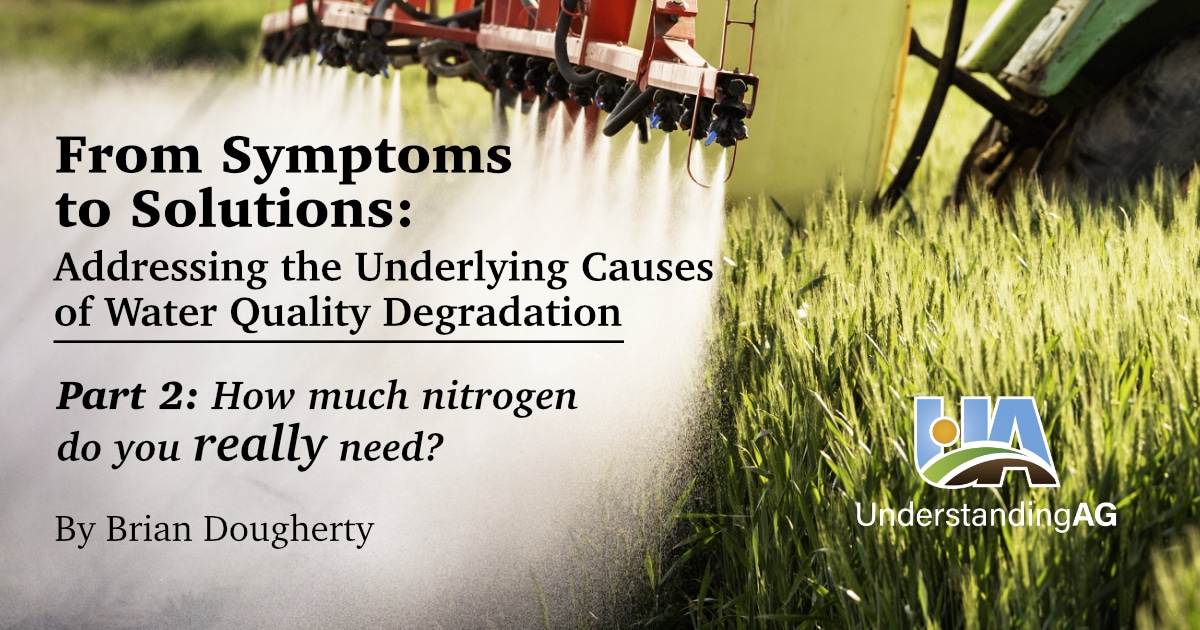
In part one of this series, I briefly discussed the importance of education for understanding how soil function and ecosystem processes play a critical role for water quality. Now let’s turn our attention to determining the “right rate” for nitrogen. Nutrient management plans focus heavily on nitrogen because it is critical for plant growth and health. But how do know how much you need to apply? While there is no single “right rate,” it’s almost certainly much less than most farmers are currently applying.
The first question to ask is how much nitrogen can your soil supply to the crop without adding any N fertilizer? Nitrogen rate trials with zero N check strips can help answer this question. These trials help determine the nitrogen use efficiency (NUE) of your crop. This is commonly measured as pounds of nitrogen applied per bushel of grain harvested. Let’s use corn as an example. A producer recently shared some yield data from a replicated, on-farm trial they conducted (Table 1). How would you decide which is the best application strategy if this was data from your farm?

In this example, N use is clearly more efficient as application rate declines. In this situation it’s probably due to the spring application being more efficient than fall (less N loss), and/or the soil is inherently productive and just doesn’t need that much N. To make a fair comparison, we need to account for the cost of N and the yield differences. Column 4 shows the cost of N per bushel (not including application) using a price of $0.60/lb N for urea and $0.52/lb N for anhydrous ammonia. Revenue per acre after paying for the N is shown in column 5.
From an economic standpoint, spring urea at 120 lb comes out on top in this simple analysis. But there is more to it than that. What is the cost of the additional N that was applied for very little yield gain? Let’s look at NUE another way – how much additional N was applied per bushel of yield gain, using the lowest yielding practice as a baseline. Think of this as your marginal N use efficiency. Now things look a little less rosy for the higher N rates. At the 195 lb application rate it took between 12.8 and 20.2 pounds of additional N per bushel to achieve that last bit of yield gain. Now even the 120 lb N rate doesn’t look so great. Is it really worth spending almost $4/bu just for the nitrogen, with a corn price of $4.50?

At this point you are probably thinking this is an extreme example and doesn’t apply to your farm. Surely you would lose more yield at lower N rates, right? Let’s look at data from the Corn Nitrogen Rate Calculator for comparison. This tool averages out data from hundreds of yield trials to estimate economic optimum N rates for the Upper Midwest. Some of the trials include a zero N check strip, which is a great way to find out how productive your soil is without added N. Using a $4.50/bu corn price and an N price of $0.56/lb, it produces the graph you see in Figure 1. It shows the percent of maximum yield you could reasonably expect in an average year in Iowa at various N rates. I added the black arrows and text to emphasize the following points.

Using Iowa data as an example, let’s assume the maximum return to nitrogen rate (MRTN) of 139 lb for corn after soybeans would yield around 200 bu/acre (the state average yield in Iowa) on an average farm in an average year. The MRTN for continuous corn is 182 lb N using the same assumptions. The MRTN is defined as “The N rate where the economic net return to N application is maximized.” This is roughly the point where the last additional dollar of nitrogen applied results in one dollar of yield. In other words, the tool is accounting for marginal NUE. But you should really think of it as the ‘zero return to nitrogen’ rate rather than the maximum return rate, because it’s the point at which you start losing money by adding more N. Your maximum return to N comes from the lowest application rate and declines from there as you add more N. In Figure 1, the cost of pound number 139 of nitrogen equals the revenue from the grain it produces. Spending one dollar to get one dollar back is zero return, not maximum return!
In the next part of the series, I’ll provide some additional insights, facts and figures to further illustrate why nitrogen efficiency is the key to reducing use and increasing profits, and I’ll examine why soil biology and soil function play a much more important role than most producers realize.
